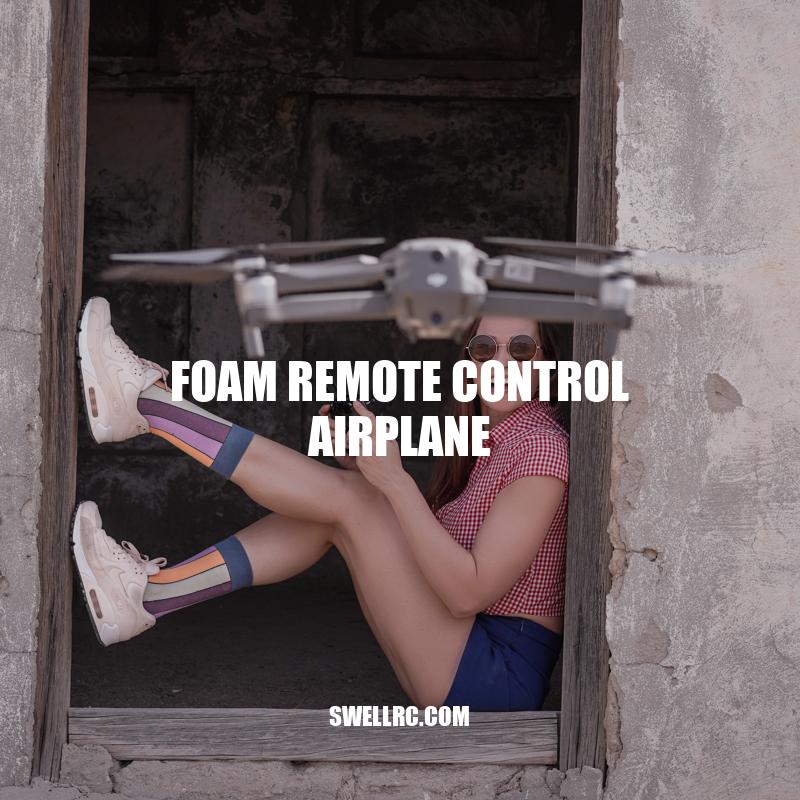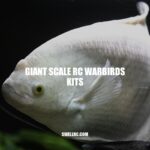Foam Remote Control Airplanes: A Guide to Flying and Maintaining the Best Toy Planes
Foam remote control airplanes are a favorite among aviation hobbyists who are looking for an affordable and durable option to hone their flying skills. RC planes made of foam materials not only withstand damage from collisions and crashes but also provide beginner pilots with a cost-effective way to learn to fly an airplane. The popularity of foam remote control airplanes has grown rapidly as more people find airplanes that are easy to control, simple to maintain, and fun to fly. Beginners can choose from a wide range of models and designs of foam remote control airplanes that feature stable and secure flight functionality, making them ideal for anyone who wants to experience the thrill of flying a plane for the first time or improving their skills.
Experienced pilots can also enjoy the benefits of foam remote control airplanes, especially when it comes to performing challenging aerobatic maneuvers. These planes can provide high-speed transportation and high-flying stunts that are sure to get your adrenaline pumping. There are different sizes and models of foam remote control airplanes that cater to different skill levels, from beginners to advanced pilots. Additionally, some foam remote control airplanes are ready to fly out-of-the-box, while others require some assembly.
The wide range of foam remote control airplanes available shows how these toys are suitable for a wide variety of users, from kids to adults, from beginners to experts. They offer a new level of excitement and enjoyment in the world of aviation, and with the right upkeep and maintenance, can provide you with years of thrilling flying experiences.
Types and sizes of foam remote control airplanes
There are many different types and sizes of foam remote control airplanes available in the market, designed to cater to different skill levels and preferences. Here are some of the most common types and sizes of foam remote control airplanes available today:
- Trainers: Foam remote control airplanes that are easy to fly, they tend to be stable and have low wing loading, which means they have a good lift-to-weight ratio. They are ideal for beginners as they make it easier to learn to fly.
- Sport: These types of foam remote control airplanes have a more aerodynamic design and are slightly more complicated to fly than trainers. They fly faster and are more agile than the trainers.
- Aerobatic: Advanced foam remote control airplanes designed for expert pilots and enthusiasts looking for a challenge. They can perform high-speed stunts and require more skill to fly.
In addition to these categories, some foam remote control airplanes are designed for specific purposes such as combat, surveillance, and photography. Some popular brands for these types of toys include the E-flite Apprentice STS, Hobbyzone Sport Cub S, and Dynam Hawksky V2. These brands offer a wide range of foam remote control airplanes that cater to different skill levels. Hobbyists can also find a vast selection of foam remote control airplanes on websites such as Horizon Hobby, Amazon, and Tower Hobbies, where they can choose from different models, sizes, and prices.
What are the different types of RC plane foam?
RC planes are made using different types of foam, each having its own unique properties. Generally speaking, RC planes are made to be durable and lightweight. The main types of foam used to make RC planes are Expanded Polystyrene (EPS), Expanded Polypropylene (EPP), Expanded Polyolefin (EPO), and Depron. EPS is the most commonly used foam, and it is known for its lightweight and durable nature. EPP is tougher and more durable than EPS and is often used for planes that experience crashes. EPO is the densest foam of all and is known for its strength. Depron is a lightweight foam that is easy to work with and is often used to make smaller RC planes. Different types of foam are used for different applications. For more information on RC planes, you can visit websites such as Horizon Hobby, Hobbyking, and Flite Test.
Foam remote control airplanes have various features and capabilities that make them ideal for enthusiasts and hobbyists alike. Here are some of the features and capabilities of foam remote control airplanes worth noting:
- Flight time: Foam remote control airplanes have an average flight time of 10-15 minutes on a single battery charge.
- Range: The range of a foam remote control airplane depends on the type and model, but most have a range of several hundred yards.
- Speed: Foam remote control airplanes can fly at various speeds depending on the type and motor used. The average speed range is between 15-50 mph (24-80 km/h).
- Maneuverability: Foam remote control airplanes can perform a variety of maneuvers including loops, rolls, stalls, and inverted flight. More aerobatic models are designed to perform more complex maneuvers such as knife-edge, torque roll, and snap rolls.
- Camera Capability: Some foam remote control airplanes come equipped with cameras that allow users to take aerial photos or record videos of their flight.
- Size: Foam remote control airplanes come in different sizes, but most are between 20-40 inches (50-100 cm) in wingspan.
The World Record for “Most Time Aloft for an RC Model Airplane” was set in 2018 by Jim Parker in Texas, USA. His RC airplane stayed airborne for an astounding 202 hours and 52 minutes!
Different models of foam remote control airplanes vary in features and capabilities. Hobbyists can choose from nitro, electric, or gas-powered foam airplanes, depending on their preferences. Some popular electric foam remote control airplanes include the E-flite Timber, ZOHD Dart, and FMS Easy Trainer. These brands offer different motors, batteries, and features that cater to different flight styles and skill sets. Additionally, hobbyists can learn more about the features and capabilities of foam remote control airplanes by visiting websites such as RCPowers and RCGroups, where they can find a wealth of information about foam remote control airplanes, as well as join discussion forums to connect with other enthusiasts.
What foam is used for RC planes?
The foam materials commonly used for RC planes are Expanded Polystyrene (EPS), Expanded Polypropylene (EPP), Expanded Polyolefin (EPO) and Depron. These foams are chosen for their durability and ability to withstand crashes. For more information on RC planes and materials used, check out hobbyist websites such as Flite Test or RC Groups.
Tips and Tricks for Flying Foam Remote Control Airplanes
Practicing with foam remote control airplanes can be an exciting and enjoyable experience, but it can be challenging for beginners and even experienced pilots. Here are some tips and tricks that can help you improve your flying skills and have a more enjoyable time while piloting a foam remote control airplane.
- Before flying, make sure you have read the instructions and familiarized yourself with the airplane’s features and control.
- Find an appropriate location for flying your foam remote control airplane, such as a park or open field without any obstructions that can interfere with the airplane’s path.
- Start with shorter and lower flights. It is essential to move gradually, familiarizing with the controls and your airplane’s behavior.
- Practice different maneuvers, such as maintaining a level flight, performing turns, and flying in a straight line.
- Practice taking off and landing the airplane before attempting more advanced maneuvers.
- Use mild control inputs and avoid over-controlling the aircraft, which can lead to a crash.
- Using the appropriate type of battery and motor is crucial to ensure smooth and safe flight.
- Joining an online forum or community can help you connect with other hobbyists and gather valuable information and advice about flying foam remote control airplanes.
Some websites can help hobbyists find tips and tricks about flying foam remote control airplanes. For instance, RCGroups and FliteTest feature blogs, tutorial videos, and discussions about various aspects of foam remote control airplanes. Additionally, foam remote control airplane brands like E-flite and FMS offer product manuals, video tutorials and helpful links on their websites to help their customers learn more about their products.
Fun Fact: It is illegal to fly RC planes within 5 miles of an airport without FAA authorization, according to the Federal Aviation Administration.
| Tips for Flying Foam Remote Control Airplanes |
|---|
| Read product instructions before flying |
| Find an open, obstruction-free location for flying |
| Start with shorter, lower flights to familiarize yourself with the controls |
| Practice different maneuvers and landings |
| Use mild control inputs and avoid over-controlling the aircraft |
| Use the appropriate type of battery and motor for your flight style |
| Connect with other hobbyists for advice and information |
How do you learn to fly a remote control plane?
Learning to fly a remote control plane requires practice and patience. The best way to begin is by finding an instructor or joining a local flying club. You can also find helpful tutorials and instructional videos on websites like YouTube. There are many resources available to help beginners learn the basics of flying, from choosing the right plane to mastering takeoff and landing. One helpful tutorial can be found at https://www.youtube.com/watch?v=3sdJCQ3Ic8I.
Maintenance and Upkeep for Foam Remote Control Airplanes
Maintaining your foam remote control airplane is crucial to ensure its longevity and smooth performance. Here are some tips on how to care for your airplane and keep it in good condition.
- After each flight, inspect your airplane for any damage or wear and tear that may need to be repaired.
- Clean the airplane regularly by wiping it with a damp, soft cloth to remove any dirt or dust that may accumulate on its surface.
- Check the battery and motor performance regularly and replace them when necessary.
- Store your foam remote control airplane in a cool, dry place away from direct sunlight and moisture to avoid warping and damage to its components.
- If you notice that some parts of the airplane are damaged or need to be replaced, visit your local hobby store or order quality replacements online.
- If you are handy and interested in making modifications or customizations to your foam remote control airplane, there are many tutorials and videos online to help you learn how to do so effectively.
In addition to physical maintenance, there are a few things you can do to ensure your foam remote control airplane performs at its best, such as:
- Balance the airplane and ensure its weight is distributed evenly to improve its stability and performance.
- Calibrate the remote control to improve its accuracy and responsiveness when controlling the airplane.
- Use high-quality radio equipment that offers a good range and stable connection for a safer and more enjoyable flying experience.
Some websites offer hobbyists with resources and products related to foam remote control airplane maintenance. For instance, Horizon Hobby is a popular online store that specializes in selling various types of foam remote control airplanes. They also have a dedicated section on their website that offers spare parts and repairs services for their products. Additionally, websites like RCGroups and FliteTest provide maintenance tips and advice in their blog sections, and there are also many forums where hobbyists can share their experiences and help each other with airplane maintenance and repairs.
| Maintenance Tips for Foam Remote Control Airplanes |
|---|
| Inspect the airplane after each flight |
| Clean the airplane regularly with a soft cloth |
| Check and replace the battery and motor performance when necessary |
| Store the airplane in a cool, dry place |
| Replace damaged parts with high-quality replacements |
| Use online resources and tutorials to learn how to make modifications |
How do you protect a foam RC plane?
To protect a foam RC plane, it is essential to add a clear coat to the exterior. A clear coat not only gives a glossy finish but also shields the foam from the elements and UV rays. You can use any clear coat that is compatible with foam such as Minwax Polycrylic, Krylon UV-Resistant Clear or even Rust-Oleum Clear Enamel Spray. In addition to clear coating, you can also reinforce the foam by adding fiberglass or carbon fiber strips to the wings or fuselage. This will add strength and durability to the plane. For more detailed instructions, check out the video tutorial on YouTube by FliteTest titled “How To Protect Your Foam Board RC Plane”.
Conclusion
In conclusion, foam remote control airplanes are becoming increasingly popular for their durability, flexibility, and affordability. Whether you are a beginner or an experienced pilot, there is a foam remote control airplane that can cater to your needs and interests. With a variety of models, designs, and features available on the market, hobbyists can find a foam remote control airplane that fits their style and budget.
To get the most out of your foam remote control airplane, proper maintenance and care are crucial. Regularly inspecting, cleaning, and repairing your airplane can help ensure its longevity and smooth performance. Additionally, incorporating physical adjustments and using high-quality radio equipment can improve its flight performance and accuracy.
Thankfully, there are several online resources and communities available for foam remote control airplane enthusiasts to learn from and connect with. From online hobby stores that offer a wide range of products and spare parts to instructional videos and forums, hobbyists can find help and advice on everything from airplane modifications to repairs.
In short, foam remote control airplanes are a fun and exciting way to enjoy the hobby of flying without breaking the bank. With the right care and attention, hobbyists can keep their foam remote control airplanes in top condition and continue enjoying the thrill of flying for years to come.



